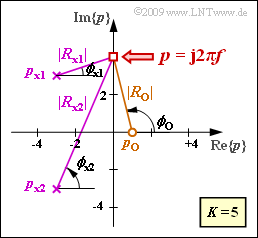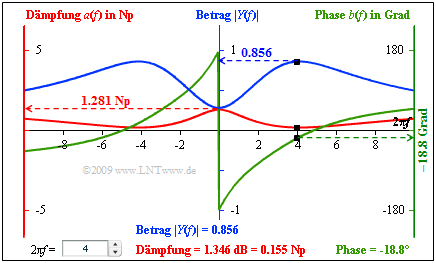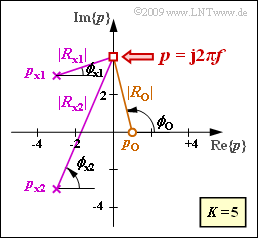Difference between revisions of "Aufgaben:Exercise 3.4: Attenuation and Phase Response"
(Die Seite wurde neu angelegt: „ {{quiz-Header|Buchseite=Lineare zeitinvariante Systeme/Laplace–Transformation und p–Übertragungsfunktion }} right| :Wi…“) |
|||
| (34 intermediate revisions by 4 users not shown) | |||
| Line 1: | Line 1: | ||
| − | {{quiz-Header|Buchseite= | + | {{quiz-Header|Buchseite=Linear_and_Time_Invariant_Systems/Laplace_Transform_and_p-Transfer_Function |
}} | }} | ||
| − | [[File:P_ID1768__LZI_A_3_4.png|right|]] | + | [[File:P_ID1768__LZI_A_3_4.png|right|frame|Pole-zero diagram and definition of some auxiliary quantities]] |
| − | + | We assume the sketched pole–zero diagram, i.e. the values | |
| − | :$$K | + | :$$K = 5, \hspace{0,2cm}Z = 1, \hspace{0,2cm}N = 2, $$ |
| − | + | :$$ p_{\rm o}= 1,\hspace{0,2cm}p_{\rm x1}= -3 + 3{\rm j},\hspace{0,2cm}p_{\rm x2}= -3 - 3{\rm j}\hspace{0.05cm} .$$ | |
| − | + | Thus, the $p$–transfer function is: | |
:$$H_{\rm L}(p)= K \cdot \frac {p - p_{\rm o }} | :$$H_{\rm L}(p)= K \cdot \frac {p - p_{\rm o }} | ||
{(p - p_{\rm x 1})(p - p_{\rm x 2})} | {(p - p_{\rm x 1})(p - p_{\rm x 2})} | ||
\hspace{0.05cm} .$$ | \hspace{0.05cm} .$$ | ||
| − | + | Considering the substitution $p = {\rm j} \cdot 2 \pi f$, the conventional transfer function can be specified, which is also called "frequency response": | |
:$$H(f) = H_{\rm L}(p)\Bigg |_{\hspace{0.1cm} p\hspace{0.05cm}=\hspace{0.05cm}{\rm j \hspace{0.05cm}2\pi \it | :$$H(f) = H_{\rm L}(p)\Bigg |_{\hspace{0.1cm} p\hspace{0.05cm}=\hspace{0.05cm}{\rm j \hspace{0.05cm}2\pi \it | ||
f}} = {\rm e}^{-a(f)\hspace{0.05cm}}\cdot {\rm e}^{- \hspace{0.05cm}{\rm j} \hspace{0.05cm}\cdot \hspace{0.05cm}b(f)} | f}} = {\rm e}^{-a(f)\hspace{0.05cm}}\cdot {\rm e}^{- \hspace{0.05cm}{\rm j} \hspace{0.05cm}\cdot \hspace{0.05cm}b(f)} | ||
\hspace{0.05cm}.$$ | \hspace{0.05cm}.$$ | ||
| − | + | From this equation it can also be seen the relationship between | |
| + | *the transfer function $H(f)$, | ||
| + | *the attenuation function $a(f)$ and | ||
| + | *the phase function $b(f)$. | ||
| + | |||
| + | |||
| + | The attenuation and phase values can be determined as follows for a frequency $f$ indirectly specified by the point $p = {\rm j} \cdot 2 \pi f$ : | ||
:$$a(f)\hspace{0.15cm}{\rm in}\hspace{0.15cm}{\rm Np} \hspace{0.25cm} = \hspace{0.2cm} -{\rm ln} \hspace{0.1cm} K | :$$a(f)\hspace{0.15cm}{\rm in}\hspace{0.15cm}{\rm Np} \hspace{0.25cm} = \hspace{0.2cm} -{\rm ln} \hspace{0.1cm} K | ||
+ {\rm ln} \hspace{0.1cm} |R_{\rm x1}|+{\rm ln} \hspace{0.1cm} |R_{\rm x1}|- {\rm ln} \hspace{0.1cm} |R_{{\rm o} }|\hspace{0.05cm} | + {\rm ln} \hspace{0.1cm} |R_{\rm x1}|+{\rm ln} \hspace{0.1cm} |R_{\rm x1}|- {\rm ln} \hspace{0.1cm} |R_{{\rm o} }|\hspace{0.05cm} | ||
| − | , | + | ,$$ |
| − | + | :$$ b(f)\hspace{0.15cm}{\rm in}\hspace{0.15cm}{\rm rad} \hspace{0.25cm} = \hspace{0.2cm} | |
\phi_{\rm x1}+ \phi_{\rm x2}-\phi_{\rm o} | \phi_{\rm x1}+ \phi_{\rm x2}-\phi_{\rm o} | ||
\hspace{0.05cm} .$$ | \hspace{0.05cm} .$$ | ||
| − | + | The corresponding magnitudes $|R_{\rm o}|$, $|R_{\rm x1}|$ and $|R_{\rm x2}|$ as well as the angles $\phi_{\rm o}$, $\phi_{\rm x1}$ and $\phi_{\rm x2}$ can be taken from the graph . | |
| + | |||
| + | |||
| + | |||
| + | |||
| + | |||
| + | Please note: | ||
| + | *The exercise belongs to the chapter [[Linear_and_Time_Invariant_Systems/Laplace_Transform_and_p-Transfer_Function|Laplace Transform and p-Transfer Function]]. | ||
| + | |||
| + | |||
| + | |||
| − | |||
| − | === | + | ===Questions=== |
<quiz display=simple> | <quiz display=simple> | ||
| − | { | + | {Compute $H(f)$. What is its magnitude at very large frequencies? |
|type="{}"} | |type="{}"} | ||
| − | $| | + | $|H(f → ∞)| \ = \ $ { 0. } |
| − | { | + | {Compute the magnitude frequency response and the attenuation value for $f → 0$. |
|type="{}"} | |type="{}"} | ||
| − | $|H(f = 0)|$ | + | $|H(f = 0)| \ = \ $ { 0.278 3% } |
| − | $ | + | $a(f = 0) \ = \ $ { 1.281 3% } $\ \rm Np$ |
| − | { | + | {Compute the attenuation value at $f =4/(2 \pi)$ in neper $\rm(Np)$ and decibel $\rm(dB)$ according to the described approach. |
|type="{}"} | |type="{}"} | ||
| − | $a(f = 2/ \pi)$ | + | $a(f = 2/ \pi)\ = \ $ { 0.155 3% } $\ \rm Np$ |
| − | $a(f = 2/ \pi)$ | + | $a(f = 2/ \pi)\ = \ $ { 1.346 3% }$\ \rm dB$ |
| − | { | + | {Compute the phase value at frequency $f = 4/(2 \pi)$ according to the described approach. |
|type="{}"} | |type="{}"} | ||
| − | $b(f = 2/ \pi)$ | + | $b(f = 2/ \pi)\ = \ $ { -19.3--18.3 } $\ \rm Grad$ |
| Line 58: | Line 73: | ||
</quiz> | </quiz> | ||
| − | === | + | ===Solution=== |
{{ML-Kopf}} | {{ML-Kopf}} | ||
| − | + | '''(1)''' The $p$–transfer function is: | |
:$$H_{\rm L}(p)= K \cdot \frac {p - p_{\rm o }} | :$$H_{\rm L}(p)= K \cdot \frac {p - p_{\rm o }} | ||
{(p - p_{\rm x 1})(p - p_{\rm x 2})} | {(p - p_{\rm x 1})(p - p_{\rm x 2})} | ||
\hspace{0.05cm} .$$ | \hspace{0.05cm} .$$ | ||
| − | + | *The conventional transfer function (the frequency response) is obtained via the substitution $p = {\rm j} \cdot 2 \pi f$: | |
:$$H(f)= K \cdot \frac {{\rm j \hspace{0.05cm}2\pi \it | :$$H(f)= K \cdot \frac {{\rm j \hspace{0.05cm}2\pi \it | ||
f} - p_{\rm o }} | f} - p_{\rm o }} | ||
| Line 74: | Line 89: | ||
\hspace{0.05cm} .$$ | \hspace{0.05cm} .$$ | ||
| − | + | *In the limiting case $f → \infty$, the following is obtained for the magnitude, attenuation and phase: | |
:$$\lim_{f \hspace{0.05cm}\rightarrow \hspace{0.05cm}\infty} H(f)= \frac{K}{{\rm j \hspace{0.05cm}2\pi \it | :$$\lim_{f \hspace{0.05cm}\rightarrow \hspace{0.05cm}\infty} H(f)= \frac{K}{{\rm j \hspace{0.05cm}2\pi \it | ||
| − | f}}\hspace{0.15cm}\Rightarrow \hspace{0. | + | f}}\hspace{0.15cm}\Rightarrow \hspace{0.15cm}\lim_{f \hspace{0.05cm}\rightarrow \hspace{0.05cm}\infty} |H(f)|\hspace{0.15cm}\underline {= 0} \hspace{0.05cm} |
| − | \Rightarrow \hspace{0. | + | \Rightarrow \hspace{0.15cm}\lim_{f \hspace{0.05cm}\rightarrow \hspace{0.05cm}\infty} a(f)= \infty,\hspace{0.1cm} |
| − | \lim_{f \hspace{0.05cm}\rightarrow \hspace{0.05cm}\infty} b(f)= | + | \lim_{f \hspace{0.05cm}\rightarrow \hspace{0.05cm}\infty} b(f)\underline {= |
| − | + | {\pi}/{2}\hspace{0.1cm}(+90^\circ)} | |
\hspace{0.01cm}.$$ | \hspace{0.01cm}.$$ | ||
| − | : | + | |
| + | |||
| + | '''(2)''' From the general equation in subtask '''(1)''' the following is obtained with the limit process $f → 0$: | ||
| + | [[File:P_ID1769__LZI_A_3_4_d_neu.png|right|frame|Magnitude (⇒ Betrag) $|H(f)|$, <br>attenuation (⇒ Dämpfung) $a(f)$ and phase $b(f)$]] | ||
:$$|H(f=0)|= -\frac {K \cdot p_{\rm o }} | :$$|H(f=0)|= -\frac {K \cdot p_{\rm o }} | ||
{p_{\rm x 1}\cdot p_{\rm x 2}} | {p_{\rm x 1}\cdot p_{\rm x 2}} | ||
| Line 91: | Line 109: | ||
:$$a(f=0)=- {\rm ln} \hspace{0.1cm}\hspace{0.15cm}\underline { |H(f=0)|= 1.281\,{\rm Np }} | :$$a(f=0)=- {\rm ln} \hspace{0.1cm}\hspace{0.15cm}\underline { |H(f=0)|= 1.281\,{\rm Np }} | ||
\hspace{0.05cm} .$$ | \hspace{0.05cm} .$$ | ||
| − | |||
| − | |||
| − | : | + | The screen capture of the Flash–module "Causal Systems" summarizes the results of this exercise: |
| − | : | + | :*middle axis (blue): magnitude $|H(f)|$, ⇒ here labeled with $|Y(f)|$, |
| − | : | + | :*left axis (red): attenuation $a(f)$, |
| − | : | + | :*right axis (green): phase $b(f)$. |
| − | + | :*black point: values for $2\pi f = 4.$ | |
| − | |||
| − | : | + | [[File:P_ID2843__LZI_A_3_4.png|right|frame|Pole-zero diagram and some auxiliary quantities]] |
| − | [[ | + | '''(3)''' According to the detailed description in the [[Linear_and_Time_Invariant_Systems/Laplace_Transform_and_p-Transfer_Function#Graphical_determination_of_attenuation_and_phase|theory part]], the following holds for the attenuation function: |
| + | |||
:$$a(f)= -{\rm ln} \hspace{0.1cm} K | :$$a(f)= -{\rm ln} \hspace{0.1cm} K | ||
| − | + {\rm ln} \hspace{0.1cm} |R_ | + | + {\rm ln} \hspace{0.1cm} |R_{\rm x1}|+{\rm ln} \hspace{0.1cm} |R_{\rm x2}|- {\rm ln} \hspace{0.1cm} |R_{{\rm o} }|\hspace{0.05cm} .$$ |
| − | + | *Furthermore, the additional unit "neper" $\rm (Np)$ must be taken into account. | |
| − | + | *The attenuation at $f = 2/\pi$ is searched-for. For this, we set $p = {\rm j} \cdot 2 \pi f = 4$ and determine the following distances: | |
| − | + | :$$R_{\rm o} = 1 - 4 \cdot {\rm j}, \hspace{0.2cm}|R_{\rm o}| \hspace{0.25cm} = \hspace{0.2cm} \sqrt{1^2 + 4^2}= 4.123, \hspace{1.15cm} | |
| − | :$$R_{\rm o} = 1 - 4 \cdot {\rm j}, \hspace{0.2cm}|R_{\rm o}| \hspace{0.25cm} = \hspace{0.2cm} \sqrt{1^2 + 4^2}= 4.123,\ | + | {\rm ln} \hspace{0.1cm}|R_{\rm o}| |
| − | \hspace{0.25cm} = \hspace{0.2cm}1.417\,{\rm Np }\hspace{0.05cm}, | + | \hspace{0.25cm} = \hspace{0.2cm}1.417\,{\rm Np }\hspace{0.05cm},$$ |
| − | R_{\rm x1} = -3 - 1 \cdot {\rm | + | :$$R_{\rm x1} = -3 - 1 \cdot {\rm |
| − | j}, \hspace{0.2cm}|R_{\rm x1}| \hspace{0.25cm} = \hspace{0.2cm} \sqrt{3^2 + 1^2}= 3.162,\ | + | j}, \hspace{0.2cm}|R_{\rm x1}| \hspace{0.25cm} = \hspace{0.2cm} \sqrt{3^2 + 1^2}= 3.162,\hspace{0.5cm} |
{\rm ln} \hspace{0.1cm}|R_{\rm x1}| | {\rm ln} \hspace{0.1cm}|R_{\rm x1}| | ||
| − | \hspace{0.25cm} = \hspace{0.2cm}1.151\,{\rm Np }\hspace{0.05cm}, | + | \hspace{0.25cm} = \hspace{0.2cm}1.151\,{\rm Np }\hspace{0.05cm},$$ |
| − | + | :$$ R_{\rm x2} = -3 - 7 \cdot{\rm j}, | |
| − | \hspace{0.2cm}|R_{\rm x2}| \hspace{0.25cm} = \hspace{0.2cm} \sqrt{3^2 + 7^2}= 7.616,\ | + | \hspace{0.2cm}|R_{\rm x2}| \hspace{0.25cm} = \hspace{0.2cm} \sqrt{3^2 + 7^2}= 7.616,\hspace{0.5cm} |
{\rm ln} \hspace{0.1cm}|R_{\rm x2}| | {\rm ln} \hspace{0.1cm}|R_{\rm x2}| | ||
\hspace{0.25cm} = \hspace{0.2cm}2.030\,{\rm Np }\hspace{0.05cm}.$$ | \hspace{0.25cm} = \hspace{0.2cm}2.030\,{\rm Np }\hspace{0.05cm}.$$ | ||
| − | + | $$\Rightarrow \hspace{0.3cm}a(f = \frac{4}{2\pi})= | |
-{\rm ln} \hspace{0.1cm} 5 | -{\rm ln} \hspace{0.1cm} 5 | ||
+ 1.151+ 2.030- | + 1.151+ 2.030- | ||
| − | 1.417=0.155\,{\rm Np } | + | 1.417\hspace{0.15cm}\underline{=0.155\,{\rm Np }} |
\hspace{0.05cm}.$$ | \hspace{0.05cm}.$$ | ||
| − | + | This is equivalent to $0.155\ {\rm Np} \cdot 8.686 \ {\rm dB/Np} \hspace{0.15cm} \underline{= 1.346 \ {\rm dB}}$. | |
| + | |||
| − | + | '''(4)''' The following holds for the phase function according to the description in the theory section due to $K > 0$ : | |
| − | :$$b(f ={2}/\pi) = \phi_{\rm x1} + \phi_{\rm | + | :$$b(f ={2}/\pi) = \phi_{\rm x1} + \phi_{\rm x2}-\phi_{\rm o}\hspace{0.05cm},$$ |
| − | :$$\phi_{\rm x1 | + | :$$\phi_{\rm x1} ={\rm arctan}\hspace{0.15cm}(1/3) = |
| − | 18.4^\circ\hspace{0.05cm}, \hspace{0. | + | 18.4^\circ\hspace{0.05cm}, \hspace{0.5cm}\phi_{\rm x2} = {\rm arctan}\hspace{0.15cm}(7/3) = |
| − | 66.8^\circ\hspace{0.05cm},\ | + | 66.8^\circ\hspace{0.05cm},\hspace{0.5cm} \phi_{\rm o} = {\rm arctan}\hspace{0.15cm}(-1/4) = |
| − | + | 180^\circ - 76^\circ = 104^\circ $$ | |
| − | 180^\circ - 76^\circ = 104^\circ$$ | + | :$$ \Rightarrow \hspace{0.3cm}b(f ={2}/\pi) = |
| − | :$$\Rightarrow \hspace{0.3cm}b(f ={2}/\pi) = | ||
18.4^\circ + 66.8^\circ - 104^\circ \hspace{0.15cm} \underline{= -18.8^\circ} | 18.4^\circ + 66.8^\circ - 104^\circ \hspace{0.15cm} \underline{= -18.8^\circ} | ||
\hspace{0.05cm}.$$ | \hspace{0.05cm}.$$ | ||
| Line 142: | Line 158: | ||
| − | [[Category: | + | [[Category:Linear and Time-Invariant Systems: Exercises|^3.2 Laplace Transform and p-Transfer Function^]] |
Latest revision as of 16:15, 14 October 2021
We assume the sketched pole–zero diagram, i.e. the values
- $$K = 5, \hspace{0,2cm}Z = 1, \hspace{0,2cm}N = 2, $$
- $$ p_{\rm o}= 1,\hspace{0,2cm}p_{\rm x1}= -3 + 3{\rm j},\hspace{0,2cm}p_{\rm x2}= -3 - 3{\rm j}\hspace{0.05cm} .$$
Thus, the $p$–transfer function is:
- $$H_{\rm L}(p)= K \cdot \frac {p - p_{\rm o }} {(p - p_{\rm x 1})(p - p_{\rm x 2})} \hspace{0.05cm} .$$
Considering the substitution $p = {\rm j} \cdot 2 \pi f$, the conventional transfer function can be specified, which is also called "frequency response":
- $$H(f) = H_{\rm L}(p)\Bigg |_{\hspace{0.1cm} p\hspace{0.05cm}=\hspace{0.05cm}{\rm j \hspace{0.05cm}2\pi \it f}} = {\rm e}^{-a(f)\hspace{0.05cm}}\cdot {\rm e}^{- \hspace{0.05cm}{\rm j} \hspace{0.05cm}\cdot \hspace{0.05cm}b(f)} \hspace{0.05cm}.$$
From this equation it can also be seen the relationship between
- the transfer function $H(f)$,
- the attenuation function $a(f)$ and
- the phase function $b(f)$.
The attenuation and phase values can be determined as follows for a frequency $f$ indirectly specified by the point $p = {\rm j} \cdot 2 \pi f$ :
- $$a(f)\hspace{0.15cm}{\rm in}\hspace{0.15cm}{\rm Np} \hspace{0.25cm} = \hspace{0.2cm} -{\rm ln} \hspace{0.1cm} K + {\rm ln} \hspace{0.1cm} |R_{\rm x1}|+{\rm ln} \hspace{0.1cm} |R_{\rm x1}|- {\rm ln} \hspace{0.1cm} |R_{{\rm o} }|\hspace{0.05cm} ,$$
- $$ b(f)\hspace{0.15cm}{\rm in}\hspace{0.15cm}{\rm rad} \hspace{0.25cm} = \hspace{0.2cm} \phi_{\rm x1}+ \phi_{\rm x2}-\phi_{\rm o} \hspace{0.05cm} .$$
The corresponding magnitudes $|R_{\rm o}|$, $|R_{\rm x1}|$ and $|R_{\rm x2}|$ as well as the angles $\phi_{\rm o}$, $\phi_{\rm x1}$ and $\phi_{\rm x2}$ can be taken from the graph .
Please note:
- The exercise belongs to the chapter Laplace Transform and p-Transfer Function.
Questions
Solution
- $$H_{\rm L}(p)= K \cdot \frac {p - p_{\rm o }} {(p - p_{\rm x 1})(p - p_{\rm x 2})} \hspace{0.05cm} .$$
- The conventional transfer function (the frequency response) is obtained via the substitution $p = {\rm j} \cdot 2 \pi f$:
- $$H(f)= K \cdot \frac {{\rm j \hspace{0.05cm}2\pi \it f} - p_{\rm o }} {({\rm j \hspace{0.05cm}2\pi \it f} - p_{\rm x 1})({\rm j \hspace{0.05cm}2\pi \it f} - p_{\rm x 2})} = {\rm e}^{-a(f)\hspace{0.05cm}}\cdot {\rm e}^{- \hspace{0.05cm}{\rm j} \hspace{0.05cm}\cdot \hspace{0.05cm}b(f)} \hspace{0.05cm} .$$
- In the limiting case $f → \infty$, the following is obtained for the magnitude, attenuation and phase:
- $$\lim_{f \hspace{0.05cm}\rightarrow \hspace{0.05cm}\infty} H(f)= \frac{K}{{\rm j \hspace{0.05cm}2\pi \it f}}\hspace{0.15cm}\Rightarrow \hspace{0.15cm}\lim_{f \hspace{0.05cm}\rightarrow \hspace{0.05cm}\infty} |H(f)|\hspace{0.15cm}\underline {= 0} \hspace{0.05cm} \Rightarrow \hspace{0.15cm}\lim_{f \hspace{0.05cm}\rightarrow \hspace{0.05cm}\infty} a(f)= \infty,\hspace{0.1cm} \lim_{f \hspace{0.05cm}\rightarrow \hspace{0.05cm}\infty} b(f)\underline {= {\pi}/{2}\hspace{0.1cm}(+90^\circ)} \hspace{0.01cm}.$$
(2) From the general equation in subtask (1) the following is obtained with the limit process $f → 0$:
- $$|H(f=0)|= -\frac {K \cdot p_{\rm o }} {p_{\rm x 1}\cdot p_{\rm x 2}} = \frac {5 \cdot 1}{ (-3 + 3{\rm j})\cdot (-3 + 3{\rm j})}= \frac {5 }{18}\hspace{0.15cm}\underline {\approx 0.278} \hspace{0.05cm} ,$$
- $$a(f=0)=- {\rm ln} \hspace{0.1cm}\hspace{0.15cm}\underline { |H(f=0)|= 1.281\,{\rm Np }} \hspace{0.05cm} .$$
The screen capture of the Flash–module "Causal Systems" summarizes the results of this exercise:
- middle axis (blue): magnitude $|H(f)|$, ⇒ here labeled with $|Y(f)|$,
- left axis (red): attenuation $a(f)$,
- right axis (green): phase $b(f)$.
- black point: values for $2\pi f = 4.$
(3) According to the detailed description in the theory part, the following holds for the attenuation function:
- $$a(f)= -{\rm ln} \hspace{0.1cm} K + {\rm ln} \hspace{0.1cm} |R_{\rm x1}|+{\rm ln} \hspace{0.1cm} |R_{\rm x2}|- {\rm ln} \hspace{0.1cm} |R_{{\rm o} }|\hspace{0.05cm} .$$
- Furthermore, the additional unit "neper" $\rm (Np)$ must be taken into account.
- The attenuation at $f = 2/\pi$ is searched-for. For this, we set $p = {\rm j} \cdot 2 \pi f = 4$ and determine the following distances:
- $$R_{\rm o} = 1 - 4 \cdot {\rm j}, \hspace{0.2cm}|R_{\rm o}| \hspace{0.25cm} = \hspace{0.2cm} \sqrt{1^2 + 4^2}= 4.123, \hspace{1.15cm} {\rm ln} \hspace{0.1cm}|R_{\rm o}| \hspace{0.25cm} = \hspace{0.2cm}1.417\,{\rm Np }\hspace{0.05cm},$$
- $$R_{\rm x1} = -3 - 1 \cdot {\rm j}, \hspace{0.2cm}|R_{\rm x1}| \hspace{0.25cm} = \hspace{0.2cm} \sqrt{3^2 + 1^2}= 3.162,\hspace{0.5cm} {\rm ln} \hspace{0.1cm}|R_{\rm x1}| \hspace{0.25cm} = \hspace{0.2cm}1.151\,{\rm Np }\hspace{0.05cm},$$
- $$ R_{\rm x2} = -3 - 7 \cdot{\rm j}, \hspace{0.2cm}|R_{\rm x2}| \hspace{0.25cm} = \hspace{0.2cm} \sqrt{3^2 + 7^2}= 7.616,\hspace{0.5cm} {\rm ln} \hspace{0.1cm}|R_{\rm x2}| \hspace{0.25cm} = \hspace{0.2cm}2.030\,{\rm Np }\hspace{0.05cm}.$$
$$\Rightarrow \hspace{0.3cm}a(f = \frac{4}{2\pi})= -{\rm ln} \hspace{0.1cm} 5 + 1.151+ 2.030- 1.417\hspace{0.15cm}\underline{=0.155\,{\rm Np }} \hspace{0.05cm}.$$
This is equivalent to $0.155\ {\rm Np} \cdot 8.686 \ {\rm dB/Np} \hspace{0.15cm} \underline{= 1.346 \ {\rm dB}}$.
(4) The following holds for the phase function according to the description in the theory section due to $K > 0$ :
- $$b(f ={2}/\pi) = \phi_{\rm x1} + \phi_{\rm x2}-\phi_{\rm o}\hspace{0.05cm},$$
- $$\phi_{\rm x1} ={\rm arctan}\hspace{0.15cm}(1/3) = 18.4^\circ\hspace{0.05cm}, \hspace{0.5cm}\phi_{\rm x2} = {\rm arctan}\hspace{0.15cm}(7/3) = 66.8^\circ\hspace{0.05cm},\hspace{0.5cm} \phi_{\rm o} = {\rm arctan}\hspace{0.15cm}(-1/4) = 180^\circ - 76^\circ = 104^\circ $$
- $$ \Rightarrow \hspace{0.3cm}b(f ={2}/\pi) = 18.4^\circ + 66.8^\circ - 104^\circ \hspace{0.15cm} \underline{= -18.8^\circ} \hspace{0.05cm}.$$


